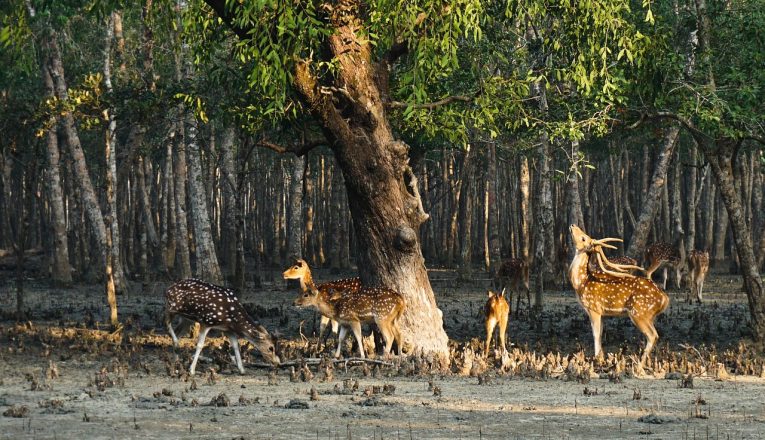Exploring the Natural Beauty of Sundarban
Outline
- Sundarban is a UNESCO World Heritage Site, and it is home to some rare and endangered wildlife species.
- The Sundarban Delta is in the southwestern part of Bangladesh and the southeastern part of India.
- Sundarban is the world’s largest delta and mangrove.
- Visit Sajnekhali Watchtower, Bhagabatpur Crocodile Sanctuary, Netidhopani, among others.
- Take part in Bonbibi mela, Rash mela, Bera utsav, and Poush mela.
Sundarban is a UNESCO World Heritage Site, and it is home to some rare and endangered wildlife species. The dense mangroves are also populated by different tribal communities that have adapted to a unique way of living.
Sundarban is named after the Sundari tree which makes up about 70% of the trees in the mangroves. Gewa, Goran, and Passur are some of the many other kinds of trees in these mangroves.
Where is Sundarban?
The Sundarban Delta is in the southwestern part of Bangladesh and the southeastern part of India. These forests are situated at the amalgamation of the Ganges, the Brahmaputra, and the Meghna River. To the east lies the Hariabhanga and Raimangal rivers and the Muri Ganga is in the west.
Reasons why Sundarban is Famous
Sundarban is famous for many reasons like:
- It is the world’s largest mangrove forest.
- Sundarban is the world’s largest delta.
- Sundarban is home to rare and endangered creatures such as the Royal Bengal Tiger, Ganges and Irawadi dolphins, and estuarine crocodiles.
- The mangroves are also home to birds including swamp francolin, mangrove whistler, crested serpent eagle, etc.
- Sundarban is dotted with ancient temples, shrines, and mosques. Netidhopani is an ancient location that has much cultural and historical importance.
- It is a UNESCO World Heritage Site.
- Sundarbans is a fishing reserve in India.
Places to visit in Sundarban
The best time to visit Sundarban is in the winter when the average temperature is between 25 and 19 degrees Celsius. This time of the year is ideal for taking a tour of the mangroves.
Tigers and other animals are spotted on the banks of rivers. Many birds migrate to the forests during winter.
The places you must visit during your stay in Sundarban tour are:
- Sajnekhali Watchtower: Situated close to Sundarbans National Park, the Sajnekhali Watchtower is a popular location for tourists. This place is a heaven for bird watchers. 20 people can stay at the tower at a time. The watchtower is visited by birds like plovers, kingfishers, pelicans, etc.
- Bhagabatpur Crocodile Sanctuary: It’s on the bank of the Saptamukhi estuary. Nature lovers are drawn to this place of the hatchery of estuarine crocodiles. Batagur Baskas are also seen here.
- Burirbari Camp: The camp is near the Bangladesh border. It’s located in the extreme southeastern part of the Sundarbans. It is a beautiful watch tower situated deep within a forest.
- Netidhopani: Netidhopani attracts spiritualists and believers to a 400-year-old temple. A tiger watch tower is another major attraction.
- Henry Island: Henry island is popular for its clean beach and impressive and tasty cuisine.
Activities to do in Sundarban
Local activities are colorful and vivid. You must take part in local activities to become a part of their cultural and traditional beliefs. The most widely known activities are:
- Bonbibi mela: The Bonbibi mela is organized to celebrate the victory of Bonbibi over Dakkin Rai. Major attractions of the mela are a local reenactment of Bonbibi’s victory, food stalls, dance, and folk music.
- Poush mela: Arranged in the winter months, it marks the end of the harvesting season. The Poush Mela offers an opportunity to see the work of the local artisans.
- Rash mela: To celebrate the birth of lord Krishna the locals organize the Rash mela every year. It is organized during August or September. The days pass quickly with folk music and dance.
- Bera Utsav: Bera Utsav is a boat race, organized by the locals. They build their boats and race against each other in the brackish waters of Sundarban.
The Final Word
Find yourself while exploring the mangroves of Sundarban. The world’s largest delta is ideal for reconnecting with nature. The land is a natural wonder.
The union of Ganga, Brahmaputra, and Meghna rivers form the fertile mangroves. Sundarban is home to a diverse and rare wildlife population.
The ideal time to visit the mangroves is between November and February. The chances of spotting tigers and other animals increase during winters. It is also the best time to watch birds as they come to the islands to avoid severe cold.
Visit the Sajnekhali watchtower, the Bhagabatpur Crocodile Sanctuary, the Burirbari Camp, and Netidhopani ghat. Remember to take part in local activities such as fishing, Bonbibi fair, Rash mela, and the Bera Utsav.



